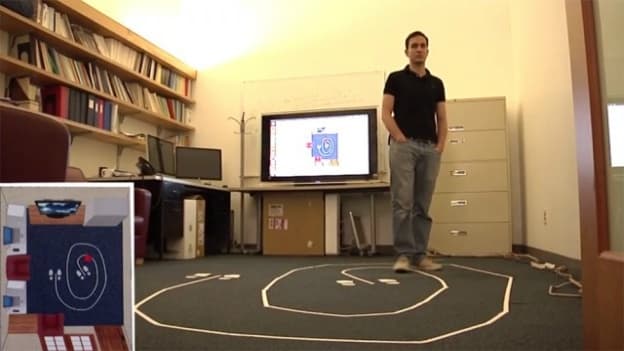MIT's WiTrack lets you see through walls; Brings 3D motion tracking for video games
A team of researchers at MIT (Massachusetts Institute of Technology) has developed a new device called WiTrack, that is a 3D motion tracking system which functions even through walls. It is able to track the 3D motion of a user from the radio signals reflected off the human body. It works even if the person is occluded from the WiTrack device or in a different room. WiTrack does not require the user to carry any wireless device, yet its accuracy exceeds current RF localization systems, which require the user to hold a transceiver. It transmits wireless signals whose power is 100 times smaller than Wi-Fi and 1000 times smaller than cellphone transmissions. Developed by the NETMIT group at MIT, the WiTrack technology has applications in gaming, elderly monitoring, and gesture-based user interfaces.
WiTrack localizes the center of a human body to within 10 to 13 cm in the x and y dimensions (about the size of an adult hand), and 21 cm in the z dimension. It also provides coarse tracking of body parts, identifying the direction of a pointing hand with a median of 11.2 degrees. It can also detect falls with 96.9% accuracy. WiTrack can be incorporated into consumer electronics and has a wide set of applications. In fact, WiTrack enables games in which users move around freely in the entire home. Unlike today's gaming interfaces (like Xbox Kinect), it does not require a player stand right in front of it to play a game. It can stalk him as he runs down hallways or hides behind furniture and walls from video game enemies.

Falls are the leading cause of both fatal and nonfatal injuries among adults aged 65 and over. Current fall detection systems require the user to wear sensors or place cameras in her home, which invade her privacy. WiTrack can detect falls with 96.9% accuracy, even through walls and simply by using reflections off a person's body. In fact, controlling household appliances is also possible with WiTrack. It allows a user to control a household appliance, like turning a light on or off, by simply pointing his or her hand in its direction - even if it is in a completely different room.
Dina Katabi, a professor of computer science and engineering and co-director of the MIT Centre for Wireless Networks and Mobile Computing and her team - which includes students Fadel Adib and Zach Kebelac as well as fellow MIT professor Robert Miller - believe the technology could one day be layered into existing motion-gaming technology to create a more immersive experience. "Imagine playing an interactive video game that transforms your entire home into a virtual world. The game console tracks you as you run down real hallways away from video game enemies, or as you hide from other players behind couches and walls. This is what WiTrack can bring to video gaming," said Dina Katabi.
Check out a video demonstration below -
WiTrack localizes the center of a human body to within 10 to 13 cm in the x and y dimensions (about the size of an adult hand), and 21 cm in the z dimension. It also provides coarse tracking of body parts, identifying the direction of a pointing hand with a median of 11.2 degrees. It can also detect falls with 96.9% accuracy. WiTrack can be incorporated into consumer electronics and has a wide set of applications. In fact, WiTrack enables games in which users move around freely in the entire home. Unlike today's gaming interfaces (like Xbox Kinect), it does not require a player stand right in front of it to play a game. It can stalk him as he runs down hallways or hides behind furniture and walls from video game enemies.

Dina Katabi, a professor of computer science and engineering and co-director of the MIT Centre for Wireless Networks and Mobile Computing and her team - which includes students Fadel Adib and Zach Kebelac as well as fellow MIT professor Robert Miller - believe the technology could one day be layered into existing motion-gaming technology to create a more immersive experience. "Imagine playing an interactive video game that transforms your entire home into a virtual world. The game console tracks you as you run down real hallways away from video game enemies, or as you hide from other players behind couches and walls. This is what WiTrack can bring to video gaming," said Dina Katabi.
Check out a video demonstration below -
0
